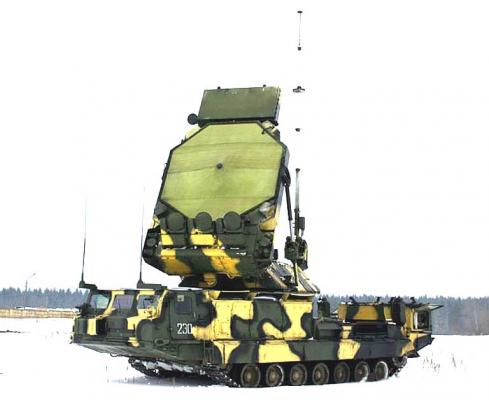Multichannel guidance station for 9C32 missiles is designed for:
- search, detection, seizure and auto-supervision of aerodynamic targets and ballistic missiles (BR) according to the target designation from the command post of the SAM system and autonomously (BR - only according to the CC with the control);
- generation and transfer of target coordinates and derived coordinates to the launchers for the purpose of pointing the target illumination stations located at these facilities, as well as SAMs, at the targets to be fired;
- fire control facilities both centrally (from the system control unit) and independently.
Station 9C32 is able to simultaneously perform sector search and accompany up to 12 targets, simultaneously control the operation of all the PU and starter charging units of the complex, transmitting to them the information necessary for starting and guiding 12 SSD on 6 targets. At the same time, the ground edge is regularly viewed to detect low-flying targets in time.
The station is a three-axis, coherent-pulse radar of a centimeter range with high energy potential, electronic beam scanning in two planes, provided by the use of PHAR station and beam control system based on a special computer. The station uses a monopulse direction finding and rangefinder method for targets and various types of probing signals to determine the coordinates of targets and their derivatives with high accuracy and resolution. Digital signal processing is used in all operating modes of the station.
There are two modes of combat operation - based on the data from the control room and autonomous operation. In the first mode, the station searches for targets in 5° sector by azimuth and 6° by angle. In the second mode - an overview of the sector ± 30 ° azimuth (relative to the bisector of the specified sector of responsibility) and from 0 ° to 18 ° by the angle of place. The azimuth (bisector) of the sector of responsibility shall be set by rotating the PHAR within ±340°.
Station 9C32 uses two types of sounding signals. Quasi-continuous signal (pulses with large discreteity) - non-modulated and with linear frequency modulation in the pack, used in the search for targets on the data from the CC, as well as for an overview of the sector of autonomous search and auto-tracking targets. Pulse signal with linear frequency modulation is used only for search in autonomous mode.
The received signals are processed by quasi-optimal filters. Formation and processing of the signal with intra-pulse linear frequency modulation is carried out on dispersion lines with high compression coefficient. Processing of the quasi-continuous signal is carried out by the correlation-filter method with integration at the intermediate frequency of the received signals by means of narrowband filters.
The systems of the multi-channel missile guidance station are controlled by a special computer in the process of searching, detection and auto tracking of targets. In case of auto tracking, the signals of errors are fed to the tracking coordinate system, which gives the computer estimates in time of coordinates and their derivatives. Based on this data, the computer closes the tracking loop by issuing control codes (signals) to the synchronizer, beam control system and other station systems. The ambiguity of range and speed determination when searching for a quasi-continuous signal is eliminated in the auto tracking mode using range derivatives.
The multi-channel missile guidance station provides detection of fighters at altitudes of more than 5km at ranges of 150km, 8K14-type BR - 90km, XMG-M52C "Lance" - 60km, MGM-31C "Pershing" head unit - 140km, SRAM-type BR - 80km. From the moment of detection to the moment of transition to auto tracking of a target with unambiguous definition of parameters of its movement passes from 5 seconds ("Pershing" and SRAM) to 11 seconds (target - fighter). When operating in autonomous mode, the multi-channel missile guidance station provided detection of fighter aircraft at ranges up to 140 km.
RMS errors in determining the range, speed and angular coordinates of targets in their auto tracking are for the fighter 5-25m in range, 0.3-1.5m / s - on speed, 0.2-2d.u. on the azimuth and the angle of the place. For the "Pershing" head unit - 4-90m in range, 1.5-35m/s in speed, 0.5-1d.c. in azimuth and angle. The resolution was 100m in range, 1° in azimuth and angle, 5m/s in speed.
The station 9C32 is a part of it:
- is an antenna system based on passive PHAR with a phase controlled beam of about 1° width, operating "in the lumen" when irradiated by its horn transmitter transmitter transmitter and receiving the reflected signals with the same switched mouthpiece (see photo1, photo2);
- a transmission system based on a chain of Klystron, developing an average power of 10-13 kW (pulsed - 150 kW);
- receiving system with amplifiers at high frequency, providing very high sensitivity - up to 10E-17W;
- beam control system;
- two special computers;
- the device of primary signal processing;
- indication system;
- control system of the main antenna and quadrature autocompensator antennas of interference;
- tracking coordinate system;
- control system and alarm system;
- telecode communication system with the system control and launchers;
- navigation system, top-mounting and orientation system;
- autonomous power supply system based on gas turbine generator;
- life support system.
All the above equipment is mounted on the tracked self-propelled "object 833" (see projections).
The weight of the station is 44 tons. Calculation - 6 people.
